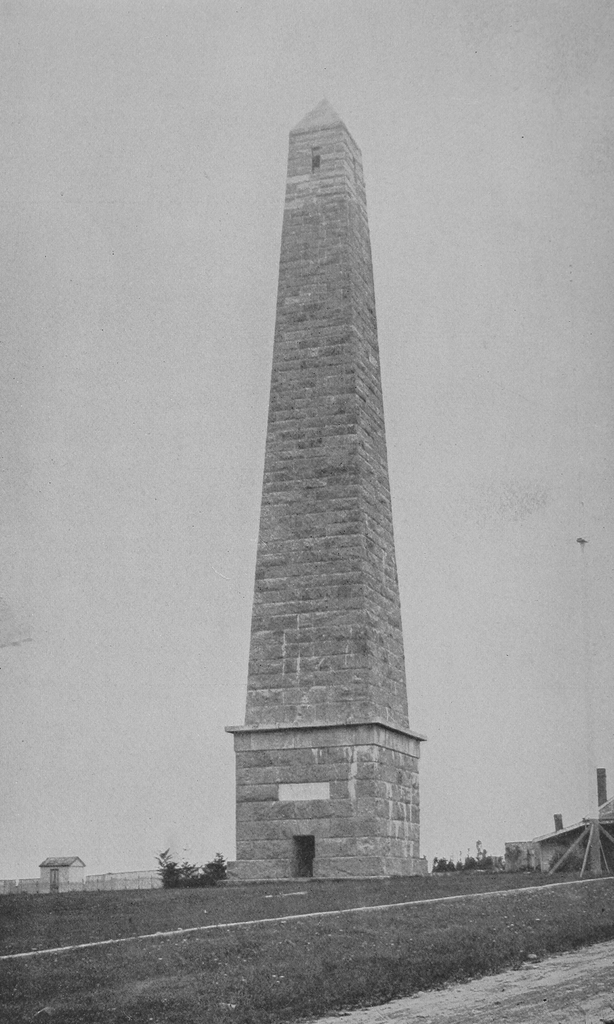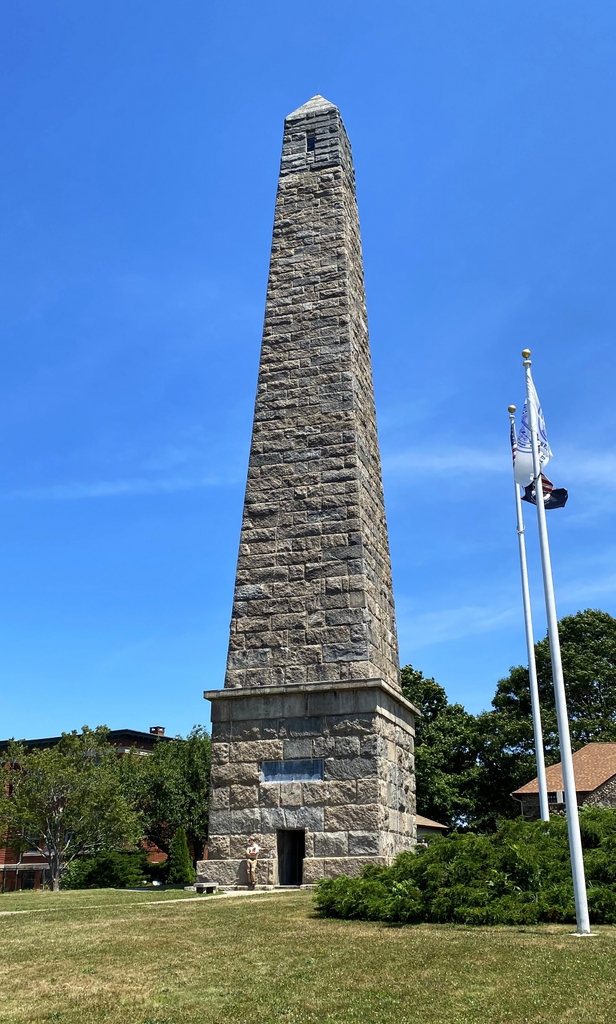The Groton Monument, seen from the southwest around 1900. Image from The Battle of Groton Heights (1903).
The monument in 2022:
These two photos show the Groton Monument, a 135-foot obelisk that memorializes the American soldiers who died at nearby Fort Griswold during the Battle of Groton Heights. It resembles the more famous Bunker Hill Monument, and these two monuments were actually built around the same time. The cornerstone for Bunker Hill was laid several months earlier, but the Groton Monument was completed in 1830, 13 years before Bunker Hill was completed.
Aside from similar designs, the two monuments also commemorate similar battles that, in many ways, bookend the American Revolution in New England. Bunker Hill was the first major battle of the war in the region, and Groton Heights was the last. Both involved relatively small numbers of Americans fighting from an elevated position against a much larger British force, and both ultimately ended as British victories, but not before the Americans inflicted heavy casualties on them. And, both were essentially pyrrhic victories; the British took substantial losses, and were unable to exploit any real strategic advantages from the battles.
In the end, about 85 American soldiers were killed here at the Battle of Groton Heights, and about 48 British soldiers. In addition, about 35 Americans were wounded, and about 145 British, and many of these wounded men on both sides subsequently died of their injuries. Making this battle particularly controversial was the fact that, according to many American accounts of the battle, most of the American losses occurred after they attempted to surrender once the British breached the walls of the fort. There are different theories about exactly what led to this, including the possibility that the British had mistakenly interpreted a flag being shot down in the midst of the battle as a signal of surrender, which then made them wary of the actual surrender later in the battle. Either way, the 160 American defenders suffered extremely high casualty rates. As a result, the battle is also sometimes referred to as the Fort Griswold Massacre.
This battle would prove to be one of the last major land battles of the war. Less than a month and a half later, the combined forces of George Washington and Jean-Baptiste de Rochambeau forced the surrender of General Cornwallis at Yorktown, Virginia, which effectively ended the war. As a result, Fort Griswold had essentially no bearing on the outcome of the war, and it was soon overshadowed by Yorktown, which might explain why it is not as well-known as some of the other major battles that occurred in New England during the war.
For many years after the war, there were very few monuments of any kind at any of the battlefields. However, this started to change somewhat by the 1820s, around the time that the surviving veterans of the war were reaching advanced ages. Over the next few decades, a handful of monuments were dedicated, ranging from relatively modest ones like the obelisk at the site of Old North Bridge in Concord, to far more ambitious ones like the 221-foot Bunker Hill Monument.
Here in Groton, there was a similar desire to memorialize the defenders of Fort Griswold. On September 6, 1825, on the 44th anniversary of the battle, the cornerstone was laid for this monument. The ceremony drew a crowd of an estimated 8,000-10,000 people, and the guests of honor included 18 survivors of the battle. One of them wore the same vest that he had worn during the battle, which still had two bullet holes in it.
The keynote speaker for the ceremony was William F. Brainard, a New London lawyer. His address, as described in the New London Gazette, “was at once patriotic, vehement, animated, original and in short most eloquent.” He covered a range of topics, including highlighting the many ways in which European powers have harmed the Americans before transitioning into discussing the specifics of this battle. Along the way, he also emphasized the many wrongs that had been committed—and were still being committed—against Native Americans. He identified it as a sin committed by their forefathers, and he also criticized Americans of his own time period for their hypocrisy in supporting missionary work in faraway places, rather than using their money to help support Native Americans here in this country.
To emphasize this last point, Brainard noted the irony of “sending to a distant land, small and pitiful donations, the spare change from the produce of farms, all of which were wrested from Indians, and some of which are cultivated by slaves.” Brainard then acknowledged that, while the topic was only partially related to his address on the American Revolution, he believed that it was important to mention the memory of the Pequots, “whose land we occupy.”
Brainard then spent the second half of his speech describing the events of the battle, and he concluded on a confident note, believing that the monument would have a long future ahead of it. He declared:
In such hands, whatever structure may be here raised, the keeping of it will be safe. The relatives and decendants of the dead may be presumed to inherit a portion of their spirit, and will defend the sepulchres of their fathers.
Never again, it may be fairly predicted, never again will this spot be invaded with success. We owe this assurance to the dead defenders of this place.
Yonder are their graves—peace to their memories!
Following the ceremony, some newspapers noted that some critics had derided the monument as merely being a copy of the Bunker Hill Monument, which had likewise just begun construction. However, as noted earlier, the Groton Monument would be completed much sooner than Bunker Hill. It was finished in 1830, although its appearance was different from these two photos. It originally stood 127 feet high, and it was topped by a cupola.
The monument would have that design throughout most of the 19th century, but in 1881 the upper part was reconstructed, with a pyramidion replacing the original cupola. As part of this project, the height of the monument was raised eight feet, bringing it to its present-day height of 135 feet.
The 1881 alterations coincided with the centennial of the battle, which was celebrated on September 6, 1881. This event was well attended, with various estimates ranging from 30,000 to 100,000 people here. It featured a reenactment of the battle, along with a speech by Senator Joseph R. Hawley of Connecticut. Prominent guests included General William T. Sherman, along with Chief Justice Morrison Waite, who was a Connecticut native.
Sherman gave a short speech at the request of the audience, and he somehow ended up talking about Native Americans, just as Brainard had almost 60 years ago. However, Sherman was not as progressive in his views as Brainard had been. He began his speech by praising the people of Connecticut, and he noted that his ancestors came from the state. However, as the Springfield Republican noted in its coverage, “[t]hen Sherman took occasion to advocate the extermination of the Indians.” He spent most of the remainder of his speech defending this reasoning, while also reminding Connecticut residents who might sympathize with the western Indians that it was Connecticut that had set this precedent by killing the Pequots early in the colonial era. This tirade does not seem to have had much direct connection to the subject at hand, although Sherman did make an attempt to compare the massacre of the fort’s defenders to the deaths of George Custer and his men at the Battle of Little Bighorn.
After Sherman, the next speaker was Congressman John T. Wait, the cousin of the Chief Justice. He was followed by the Rev. Leonard W. Bacon, who recited a poem, “The Lay of Groton Height,” that he had composed about the battle. Next was a military parade on State Street in New London, and then the day’s festivities were concluded with an elaborate fireworks display in the evening.
The first photo was taken only about 20 years after this centennial celebration, and the scene still looks largely the same as it did in the first photo, aside from more trees in the landscape today. The monument itself has not seen any significant exterior changes since then, and it is still open to the public seasonally, for those who are willing to climb the narrow 166-foot spiral staircase to the top. It is part of the Fort Griswold State Park, which also includes a small museum in the old caretaker’s house to the right, along with the preserved fort itself.


